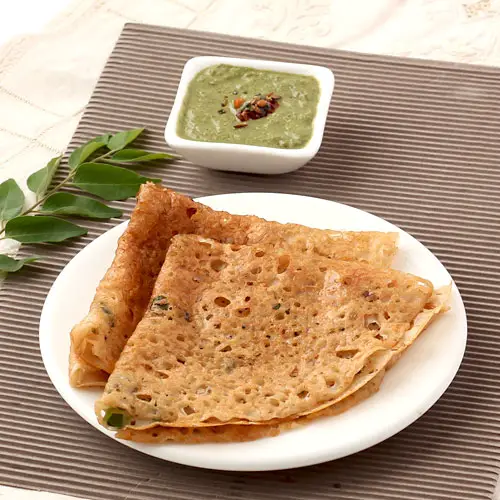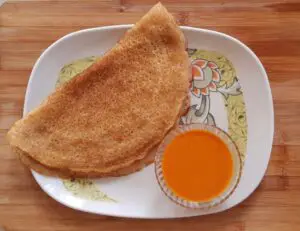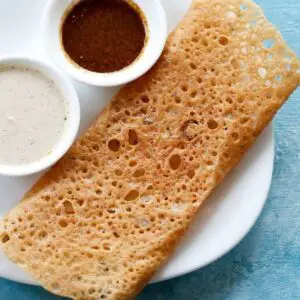Wheat dosa is a popular South Indian dish made from whole wheat flour or atta. It is a healthier alternative to the traditional dosa, which is made with rice and lentils. Wheat dosa is typically prepared by mixing wheat flour with water, adding spices and herbs for flavor, and then cooking it on a hot griddle or tawa.
Wheat dosa is often served with various accompaniments such as coconut chutney, tomato chutney, sambar (a lentil and vegetable stew), or any other side dish of your choice. It can be enjoyed by itself or rolled up with a filling of spiced potato, cheese, or vegetables to create a flavorful and filling meal.
As a whole grain-based dish, wheat dosa is a good source of dietary fiber, vitamins, and minerals. It offers a healthier alternative to regular dosas for those looking to incorporate more whole grains into their diet. It is also suitable for individuals who follow a vegetarian or vegan lifestyle.
Overall, wheat dosa is a tasty, nutritious, and easy-to-make dish that can be enjoyed by people of all ages. Its versatility allows for customization with various flavors and fillings, making it a popular choice for a quick and satisfying meal.
YOU ALSO READ
Soya chunks 65 recipes |A Delectable Delight
Ingredients for Wheat Dosa:
- 1 cup whole wheat flour (atta)
- 1/4 cup rice flour
- 1/4 cup semolina (optional)
- 1/2 teaspoon cumin seeds
- 1/2 teaspoon crushed black pepper
- 1/2 teaspoon grated ginger
- 1-2 green chilies, finely chopped
- A handful of fresh coriander leaves, finely chopped
- Salt to taste
- Water (as needed)
- Oil or ghee for cooking
Instructions for Wheat Dosa:
- In a mixing bowl, combine the wheat flour, rice flour, semolina (if using), cumin seeds, crushed black pepper, grated ginger, green chilies, coriander leaves, and salt.
- Gradually add water to the mixture while stirring continuously to make a smooth batter. The consistency should be similar to a pancake batter. Let the batter rest for about 15-20 minutes.
- Heat a griddle or tawa on medium heat and lightly grease it with oil or ghee.
- Pour a ladleful of the batter onto the center of the griddle and spread it in a circular motion to form a thin dosa.
- Drizzle some oil or ghee around the edges of the dosa and cook until the bottom turns golden brown and crisp.
- Flip the dosa and cook for another minute or until the other side is cooked as well.
- Remove the dosa from the griddle and serve hot with chutney, sambar, or any side dish of your choice.
Wheat dosa is a nutritious option as it contains the goodness of whole wheat flour. It can be enjoyed for breakfast, lunch, or dinner and is often served with coconut chutney, tomato chutney, or sambar. Feel free to experiment with the recipe by adding your favorite vegetables or spices to enhance the flavor.
Serving suggestions
- Chutneys: Coconut chutney, tomato chutney, mint chutney, or coriander chutney are classic accompaniments that pair well with wheat dosa. They add a burst of flavor and freshness to each bite.
- Sambar: Sambar is a lentil and vegetable stew that is commonly served with dosa. Its tangy and mildly spicy taste complements the flavors of the dosa. You can make sambar with a variety of vegetables like lentils, carrots, beans, and drumsticks.
- Vegetable Curry: A side dish of mixed vegetable curry or kurma can be served with wheat dosa. It adds a hearty and flavorful component to the meal. The curry can be made with a variety of vegetables cooked in a rich and aromatic sauce.
- Potato Masala: A classic filling for dosa is potato masala. It’s made by sautéing boiled and mashed potatoes with onions, green chilies, ginger, and spices like turmeric, cumin, and mustard seeds. This flavorful filling can be spread inside the dosa and rolled up before serving.
- Yogurt: A side of plain yogurt or raita can provide a cooling and creamy element to balance the flavors of the dosa. You can season the yogurt with salt, cumin powder, or chopped coriander for added taste.
- Pickles: Adding a small serving of pickle, such as mango pickle or lime pickle, can provide a tangy and spicy kick to the dosa. It adds an extra layer of flavor and complements the dosa well.
- Idli Podi: Idli podi, a dry powder made from roasted lentils, spices, and sesame seeds, is often sprinkled on dosa for an extra burst of flavor. It can be mixed with oil or ghee and used as a dip or spread.
Tips and Variations
Tips:
- Consistency of the batter: The batter for wheat dosa should be similar to pancake batter. Adjust the amount of water accordingly to achieve the right consistency. A thinner batter will result in a crispier dosa, while a thicker batter will yield a softer dosa.
- Resting the batter: Allowing the batter to rest for at least 15-20 minutes helps the flavors to meld together and results in a better-textured dosa.
- Non-stick surface: To ensure that the dosa doesn’t stick to the griddle or tawa, make sure to use a non-stick surface or lightly grease it with oil or ghee before pouring the batter.
- Spices and herbs: Feel free to customize the flavors by adding spices and herbs of your choice. You can include ingredients like crushed black pepper, cumin seeds, grated ginger, chopped green chilies, or finely chopped coriander leaves.
- Cooking temperature: Start cooking the dosa on medium heat and adjust accordingly. Too high heat can cause the dosa to brown too quickly, while low heat can result in a pale and undercooked dosa.
Variations:
- Vegetable: Add grated or finely chopped vegetables like carrots, onions, bell peppers, or spinach to the batter. This not only adds nutrition but also enhances the flavor and texture of the dosa.
- Masala: Similar to the traditional masala dosa, you can make a wheat dosa and fill it with a spicy potato masala filling. Spread the filling on one side of the dosa, fold it, and serve with chutney or sambar.
- Cheese: For a cheesy twist, sprinkle grated cheese on the dosa just before flipping it. Allow the cheese to melt and then fold the dosa. It’s a delicious variation loved by kids and cheese enthusiasts.
- Spicy: If you prefer a spicier dosa, increase the amount of green chilies or add chili powder or red pepper flakes to the batter. Adjust the spice level according to your taste.
- Herb-infused: Add a handful of finely chopped fresh herbs like coriander, mint, or curry leaves to the batter. It imparts a refreshing flavor and aroma to the dosa.
- Multigrain: Experiment by combining wheat flour with other flours like ragi (finger millet), bajra (pearl millet), or jowar (sorghum) flour to create a multigrain dosa with added nutritional value.
- Sweet: For a sweet version, add a little sugar or jaggery to the batter. You can also sprinkle some powdered cardamom or cinnamon for extra flavor. Sweet wheat dosa can be enjoyed with a drizzle of honey or a side of coconut chutney.
FAQs
- Q: Is wheat dosa healthier than regular dosa?
A: Wheat dosa is considered healthier than regular dosa because it is primarily made with whole wheat flour, which is a whole grain. Whole wheat flour contains more fiber, vitamins, and minerals compared to refined rice flour used in regular dosa. It also provides a good amount of protein.
- Q: Can I make wheat dosa without rice flour?
A: Yes, you can make wheat dosa without rice flour. Rice flour is typically added to provide crispiness to the dosa. If you omit rice flour, the dosa may be slightly softer, but it will still be delicious. You can increase the amount of wheat flour or add some semolina (sooji) to help with the texture.
- Q: Can I use other flours with wheat flour to make dosa?
A: Yes, you can experiment with different flours along with wheat flour to create variations of dosa. Some commonly used flours include ragi (finger millet), bajra (pearl millet), jowar (sorghum), or a combination of these. Mixing different flours adds nutritional value and unique flavors to the dosa.
- Q: Can I make wheat dosa gluten-free?
A: Wheat dosa is not gluten-free since it is primarily made with whole wheat flour, which contains gluten. If you require a gluten-free option, you can try using gluten-free flours like rice flour, millet flour, chickpea flour (besan), or a gluten-free flour blend specifically made for dosa.
- Q: Can I make wheat dosa instantly without fermenting the batter?
A: Yes, you can make instant wheat dosa without fermenting the batter. In the traditional recipe, the batter is left to ferment for a few hours, which enhances the flavor and texture. However, if you prefer a quick option, you can make an instant version by using buttermilk or yogurt in the batter. The batter can be used immediately without fermentation.
- Q: How do I store leftover wheat dosa batter?
A: Leftover wheat dosa batter can be stored in the refrigerator for up to 2-3 days. Transfer the batter to an airtight container and refrigerate. Before using the refrigerated batter, let it come to room temperature. You may need to add a little water to adjust the consistency if the batter thickens.
- Q: Can wheat dosa be made oil-free?
A: Yes, you can make wheat dosa with minimal or no oil. Use a non-stick griddle or tawa and cook the dosa without adding oil or ghee. This will result in a healthier, oil-free version of the dosa.
Nutritions
| Calories | 82 kcal |
| Fat | 5 g |
| Carbohydrates | 60 g |
| Sodium | 139 mg |
| Potassium | 7 mg |
| Protein | 1 g |
| Vitamin A | 25 IU |
| Calcium | 15 mg |
| Vitamin C | 0.1 mg |
| Iron | 0.5 mg |
Also, read:
- Chicken Momos Recipe (step by step)
- Paneer do pyaza recipe
- how to make paneer butter masala
- Palak Paneer Recipe
- Paneer Dum Biryani Recipe




